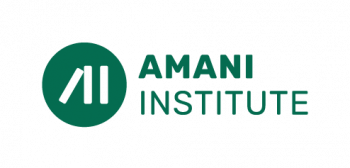“Parents shouldn’t have to choose between food or clothing,” says Janina Peter, Amani Institute Social Innovation Management Digital Class 1 Fellow. As a former World Food Program worker, she witnessed the harsh reality of refugees struggling to make ends meet. Often, food aid gets exchanged for other essentials, perpetuating a vicious cycle of poverty. However, Janina believes that the entrepreneurial talent in refugee camps can break this cycle.

Malish James (right) giving out Bridging Gaps microloans to Joska (left), an aspiring tailor, and Anthony (second from right), who opened an education station. Bidibidi community leaders oversee the exchange and the entire initiative.
The main challenge to starting a business is capital. This is where Janina’s micro loan non-profit, Bridging Gaps, comes in. With the help of Danielle Marques, Amani Institute Social Innovation Management Digital Class 2 Fellow, Bridging Gaps expanded from Uganda to Brazil. The idea originated in Bidibidi, Uganda, one of the largest refugee settlements, where Malish has been living and working since 2016. With Bridging Gaps, Malish has created new ventures that empower refugees to become entrepreneurs.
How does Bridging Gaps work?

The non-profit hosts entrepreneurship workshops with local partners, where participants create business and financial plans, form a “community loan group,” and apply for microloans to start their businesses. Approved business proposals are featured on the Bridging Gaps website and matched with donors. Micro loan recipients frequently share project updates and tell their stories. Once a micro loan is repaid, it goes to the next group member, who can start their project. Once all group members have profitable businesses, community loan groups can accept additional members. This way, new financial structures are established and the power shifts to the community.
The profound space Bridging Gaps provides offers an opportunity to break the misconceptions of microloans while creating a platform for people to discuss business ideas and create partnerships. The ultimate goal of Bridging Gaps is to become a global platform that empowers local entrepreneurs worldwide.

Danielle Marques hosting the first Bridging Gaps workshop in Rio das Pedras favela, Brazil
Example of an entrepreneurial group in Brazil
The program had to adapt to the unique challenges of Brazil. While Bridging Gaps focuses on supporting refugees in Uganda, in Brazil, the program is directed towards minorities and women. Danielle shares her experience of running the first workshop in Rio das Pedras, Brazil, in 2022. She says that a systems approach was needed to identify who could benefit the most from microloans. As Bridging Gaps operates on a grassroots and community-embedded approach, the answer for whom they would support came from their local partner. Empowering women would empower the entire community.
At the end of the first workshop, Danielle realized they had made the right choice. Being a group of entrepreneurial women in an underserved community, they shared similar experiences and challenges. They left with solutions for their business problems and a collaborative environment to return to. It was the perfect atmosphere to kick off their community-based microloan initiative.
If you want to know more about Bridging Gaps, check their website or reach out to Janina or Danielle.









